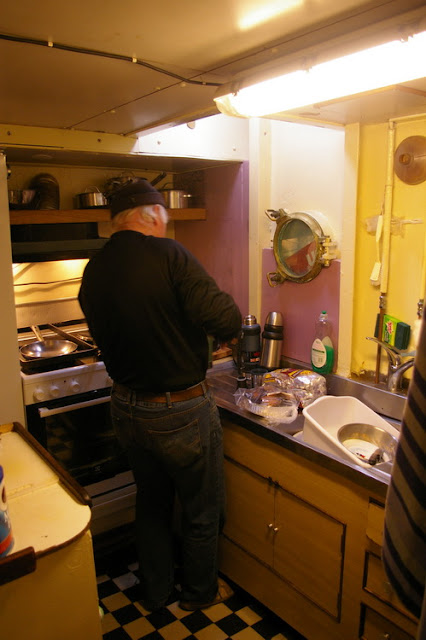Winter is definitely turning to spring now. These pictures of the melodious, elusive snow bunting prove it.
 |
| Snow Buntings - first to arrive, last to leave (Photos: courtesy GP) |
Spring also means our time living aboard and looking after Tandberg Polar has come to an end.We spent Victoria Day Monday shifting all our belongings from the tug back to Gjoa. There was a lot of 'stuff' to move and we were weren't sure how we were going to do it. Luckily, we were able to borrow a cube van and a willing helper, which was much appreciated. Thanks Gord.
 |
| Did we really take this much 'stuff'' off Gjoa? |
 |
| We have to bring the van down here? |
 |
| As close as we could get, meaning a trip across luckily still crusty-topped snow with gear. |
 |
| The tarp we used to cover the cockpit really held the snow in well ;-) |
After opening Gjoa, the initial inspection looked all good. There was only a very light sheen of moisture, a quick wipeover of the interior should be all it needs. The 'polar desert' climate did the trick as we'd hoped and there was absolutely no sign of mold or mildew. Books and charts left aboard were dry and not damp-damaged. We'd been warned to expect a lot of antifreeze in the bilge and there was a few inches of it, luckily confined just to the engine bilge. Due to our watertight bulkheads and hull tankage there are separate, isolated bilge areas throughout the boat. There was also a light film of diesel on top of the antifreeze. Apparently, the extreme cold over the winter causes the seals in the engine to contract and all the antifreeze leaks out. Let's hope the seals will have expanded themselves when we go to top up and that we don't now have a sieve for an engine.
We'd hoped to be able to do some preparatory work prior to flying out for a few weeks, but, it was still too cold to work outside so we just dumped our 'stuff' and ran. Also, June temperatures can easily still be in the -10C range, so, we didn't want to install our batteries etc. and leave them untended with the possibility of still cold temperatures to come. We have a huge job when we get back at the end of June to unpack, clean, repair and recommission Gjoa to get ready for departure, but, barring any unforeseen issues, four-five weeks should be enough time.
Stig, first mate extraordinaire, has arrived from Norway to relieve us of our duties on Tandberg Polar. After eight! long months, we can't say we were sorry to leave the tug and our stewardship duties, but, somehow it had almost begun to feel like home, even with all its faults.
 |
| Tandberg Polar galley |
 |
| Engine room view |
Although we're no longer physically onboard Tandberg Polar, it doesn't mean we no longer have interest in the Maud Returns Home project and Norway itself. We hope to see Maud out of the water and onto Jensen (barge) before we leave. Someday, we'll revisit Norway and see Maud in her final resting place near Oslo.
Since we lived and overwintered in Norway at 69N for a year we've become interested in Norway and its people. There are so few of them, just five million with a unique culture, characteristics and mindset that sets them apart from the rest of the Scandinavian countries. Somebody brought our attention to a quite funny Ted talk about Norway's creation of and passion for, 'slow tv'. It was nostalgic for us to view it as there are some great shots of the Hurtigruten (coastal cruiser) route up the entire western coast, a route we cruised in Black Sheep II in our first year of liveaboard cruising in 2010 (can't believe it's been five years since we cast off the dock lines for good). The talk is only eighteen minutes long and you can view it at:
http://www.ted.com/talks/thomas_hellum_the_world_s_most_boring_television_and_why_it_s_hilariously_addictive?language=en
I am also currently immersed in reading Norwegian author Karl Ove Knausgaard's six-volume masterwork known as 'Min Kamp' (My Struggle). I'm just starting the third volume now. The final three haven't been translated yet. It's hard to categorize, it's not a novel, it's not a memoir, it's not a diary, it's not chronological, it jumps back and forth between time and place, it's supposed to be factual and involves the most indepth examination of his life, the people and formative events in it, all viewed through his characteristic Norwegian angst . He really puts all of himself out there with what seems like great honesty and humility. It's probably not a read for everybody. The minutiae of daily life is often examined in excruciating detail. After the first volume I wasn't sure I wanted to continue, but, it is very engrossing, weirdly addictive and hard to put down. Anyway, try it if you dare, the first volume is called 'A Death in the Family' and it's on Amazon/Kindle.


